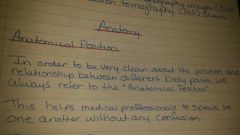![]()
![]()
![]()
Use LEFT and RIGHT arrow keys to navigate between flashcards;
Use UP and DOWN arrow keys to flip the card;
H to show hint;
A reads text to speech;
27 Cards in this Set
- Front
- Back
- 3rd side (hint)
|
Surface anatomy |
Study of superficial marking |
Gross anatomy |
|
|
Regional anatomy |
Study of a specific area |
Gross anatomy |
|
|
Systemic anatomy |
Study of system |
Gross anatomy |
|
|
Developmental anatomy |
Study of changes from conception to physical maturity |
Gross anatomy |
|
|
Cell physiology |
Study of cells |
Study of physiology |
|
|
Special physiology |
Study of a specific organ |
Physiology |
|
|
Systemic physiology |
Study of system |
|
|
|
Pathological physiology |
Study of the effects of disease on cell, tissue, organ, and systems. |
|
|
|
Organ systems |
Intregumentary Nervous Skeletal Endocrine Cardiovascular Lymphatic Urinary Respiratory Digestive Reproductive |
There are 11 of them |
|
|
Integumentary system |
Major organs: skin, nails, hair, and sweat glands Functions: Protection, temperature regulation, provides sensory information |
What's involved and what does it do? |
|
|
Nervous system |
Major organs : Brain, spinal cord, peripheral nerves, and sense organs Functions: directs immediate response to stimuli, coordinate or moderate activities of other organs, and provides/interprets sensory information about external conditions. |
|
|
|
Skeletal |
Major organs: Bones, cartilage, bone marrow, and associated ligaments. Functions: provides support and |
|
|
|
Endocrine system |
Pituitary, Thyroid and Adrenal glands, pancreas, gonads and endocrine tissue in other systems. |
|
|
|
The muscular system |
Major organs: skeletal muscles and associated tendons and aponeuroses (tendon sheets) Functions: provides movement, protection and support for other tissues. Generates heat that maintains body temperature. |
|
|
|
The cardiovascular system |
Major organs: heart, blood, and blood vessels Functions: distributes blood cells, water, and dissolved minerals, including nutrients, waste products, oxygen and carbon monoxide. Distributes heat and assists in control of body temperature. |
|
|
|
The lymphatic system |
Major organs: spleen, thymus, tonsils, lymph nodes, and lymphatic vessels Functions: defends against infections and disease and returns tissue fluids to the blood stream |
|
|
|
The urinary system |
Major organs: kidneys, urethra, urinary bladder, and ureters Functions: excreates waste products from the blood, controls water balance by regulating volume of urine produced, regulates blood ion concentration and PH, and stores urine prior to voluntary elimination |
|
|
|
The respiratory system |
Major organs: nasal cavity, bronchi, lungs, alveoli, sinuses, larynx, trachea Functions: delivers air to the alveoli, provides oxygen to bloodstream, removes carbon dioxide from the bloodstream, and produces sound for communication |
|
|
|
The digestive system |
Major organs: teeth, tongue, pharynx, esophagus, stomach, small intestine, large intestine, liver, gall bladder, and pancreas Functions: process and digest foods, absorb and conserve water, absorb nutrients and stores energy reserves |
|
|
|
Male reproductive system |
Major organs: Testes, seminal vessels, prostate gland, penis, scrotum, seminal vessels, ductus deferens Functions: produces male sex cells (sperm) and hormones |
|
|
|
Female reproductive system |
Majour organs: ovaries, uterine tubes, uterus, vagina, labia, clitoris, and mammary glands Functions: produces female sex cells (oocytes) and hormones Support developing embryo from conception to delivery and provide milk to nourish newborn infant |
|
|
|
Homeostasis |
A stable internal environment |
|
|
|
Body cavities |
Internal chambers holding and protecting vital organs and allows organs to change shape and size |
|
|
|
Two body cavities |
Dorsal: includes the cranial cavity and the spinal cavity Ventral: includes the thoracic cavity and the abdominopelvic cavity |
|
|
|
Thoracic cavity |
Contains the heart and lungs Subdivided into the left and right plural cavities |
|
|
|
The abdominopelvic cavity |
Cavity is lined by the peritoneum Extends from the diaphragm to the superior margins of the pelvis Liver, stomach, spleen, and most of the large intestine The pelvic cavity is bordered by the pelvis |
|
|
|
Anatomical position description |

|
|

